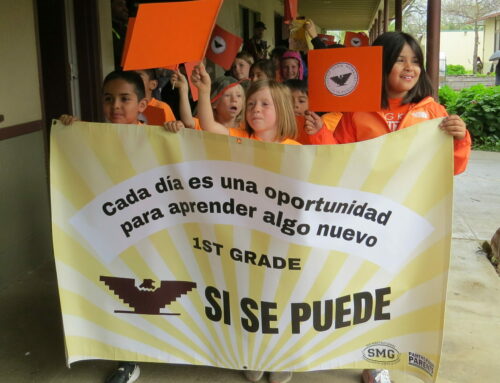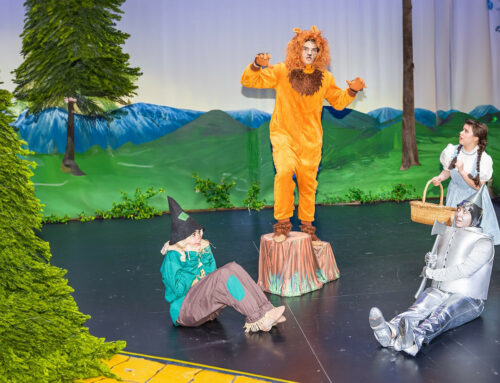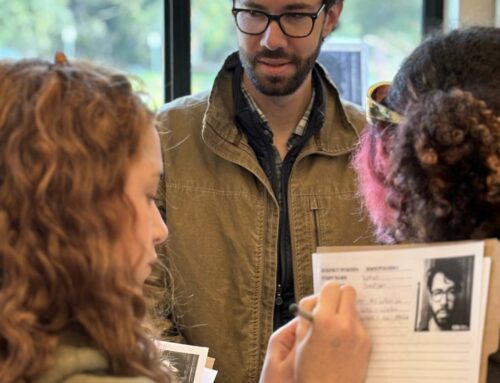48 teams, including some all-girl teams, competed
Published in the March 2-15, 2016 issue of Morgan Hill Life
By Staff Report

Photo by Marty Cheek
Two members of the Evergreen Falcons team work on their robot during the Feb. 13 Legos robotics competition at Sobrato High School.
Most young people don’t get excited about picking up trash. But at Sobrato High School Feb. 13, cheers and shouts of excitement filled the gym as 48 teams of Bay Area elementary and middle school students came together to compete in garbage collection.
This, however, was no ordinary garbage-collecting contest. The teams had all made autonomous robots using Legos and programmed with special software as part of the “Trash Trek Challenge,” a competition to encourage young people to develop engineering skills. The competition was the NorCal Silicon Valley District Championship organized by the nonprofit FIRST Lego League and also the nonprofit Playing At Learning.
Among the trash-collecting competitors was a team of six fifth-grade girls from Evergreen Elementary School in San Jose. In the first round, the Falcons beat a team of boys with their robot programmed to solve a set of missions on a playing fiend with 2.5 minutes.
Aanvi Singhani thought the experience of developing their robot helped her build camaraderie with the other girls.
“It was really fun because we got to be more friends, even though we were friends earlier. And I thought it was really fun for us because we love Legos,” she said.
Swara Rao said it was enjoyable to compete as an all-girls team and said more young girls should consider participating in the annual competition.
“We don’t enjoy boys because sometimes they can be a little obnoxious,” she said, to the laughter of her friends.
Ritali Jain joined the team when one of her friends on it encouraged her.
“Me and Nevi were friends from Taekwondo and her dad was the coach and she invited me to join First Lego League because she knows I like Legos and I’m interested in programming and technology — so I accepted her invitation,” she said.
Ananya Rao said it was an adrenaline rush as the clock ticked close to the end of the time limit and they wound up beating the guys in the first round.
“I was feeling excited and I was kind of feeling a little bit stressed-out, but it was really fun,” she said.
Jill Wilker, the FIRST Lego League program director and volunteer coordinator at Playing At Learning, said this was the fourth year the competition was held at Sobrato, hosted by the school’s robotics club. The Trash Trek contest is a fun way to encourage friendly competition and a chance for teams to learn from each other and learn specific engineering disciplines. It also serves as a way for young people to learn about problem solving, teamwork and time management skills, she said.
“The nonprofit FIRST got started in New Hampshire about 20 years ago with the idea that we need to encourage kids to be scientists and our next generation of engineers,” she said. “And the way to do that is to make engineering and science actually fun and exciting, make it more like sports and like Hollywood. Basically, they use Legos and robots as the mechanism to get kids excited about math and science.”
The grade range at the championship was between third and eighth grade, she said.
“You might think the younger kids have a disadvantage, but actually they don’t,” Wilker said. “They do quite well for themselves.”
There are 600 Lego League teams in Northern California, more than 2,000 in the state of California and more than 30,000 in 80 countries around the world. No team from Morgan Hill participated in this year’s competition. Wilker works as an engineer at Santa Clara chip-maker Intel and sees the potential for the Lego robotics competition to encourage girls to consider engineering careers.
“As a woman engineer, one of the things I’m proud of with FIRST Lego League is that 30 percent of the participants are girls. I’d love it to be 50 percent. Our goal here locally is to get to 50 percent, but 30 percent is a still strong,” she said.






